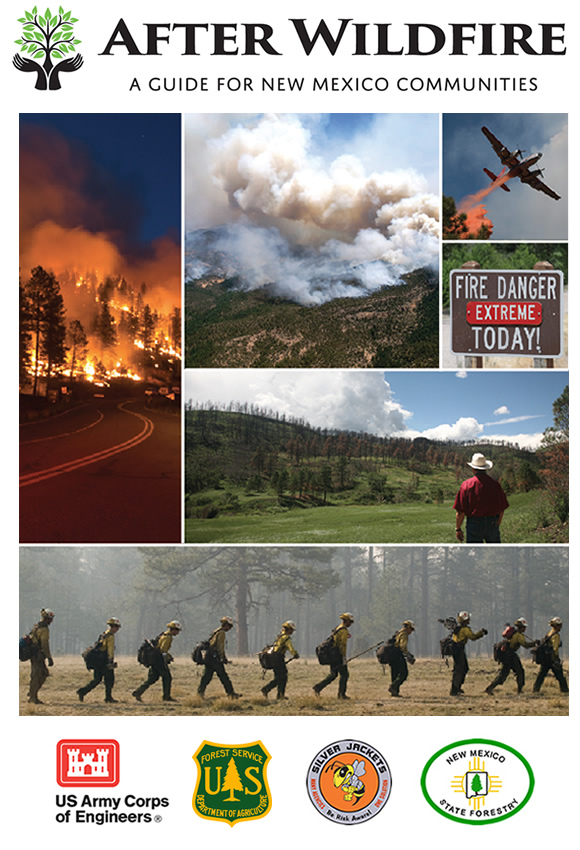
Channel Treatments
What – Mini-dams built with straw, logs, or rocks; size depends on channel gradient.
Purpose – Temporary erosion control measure designed to trap and store sediment mobilized from hillslope. Also intended to reduce downcutting and attenuate peak flows.
Effectiveness – All types of checkdams appear to work better when implemented in gentle gradients, high in the watershed, and placed in a series. Problems with checkdams include complete structure failure from large storms. In-channel treatments without adjacent hillslope treatments are ineffective.
Where
- Swales with gentle gradient that allow for sediment storage.
- High-burn severity areas with highly erodible soils.
- Areas with less than 20-percent ground cover.
- Areas with high values at risk.
- Watersheds with small drainage areas, generally less than 5 acres.
Cost – $150–600 each. Additional factors include:
- Treatment location
- Construction material used (log, straw, or rock) and availability
How to Links - See USDA BAER Catalog page 84 (PDF page 92); and NRCS Rock Check Dam Fact Sheet.
In-channel Tree Felling
What – Directionally felling trees in a staggered herringbone pattern with tops pointed upstream.
Purpose – Intended to trap floating debris and suspended sediment. Over time, large woody material dissipates stream energy, provides cover and habitat for fish while providing long-term channel stability.
Effectiveness – Directional felling appears to work better when implemented in gentle gradients, high in the watershed, and placed in a series. Problems include complete structure failure from large storms. In-channel treatments without adjacent hillslope treatments are ineffective.
Where
- Areas of high-burn severity.
- Channels where energy dissipation is necessary.
- Channels with unstable bedload and high sediment-loading potential.
Cost – $3500–4000 per mile of treatment, based on approximately 100 trees felled per mile of channel. Additional factors include:
- Location of treatment area
- Amount of material (trees) available
How to Link – See USDA BAER Catalog page 90 (PDF page 98).
Grade Stabilizer
What – Structure made of rocks, logs, or plant material installed in ephemeral channels at the grade.
Purpose – Provide grade control in channels that may become destabilized from increased storm runoff and velocities. Intended to prevent incising and downcutting in channel.
Effectiveness – Little quantitative data is available. This treatment may be most effective for areas of low or moderate flows. Grade stabilizers are likely to work better when implemented in gentle gradients, high in the watershed, and placed in a series. Problems include complete structure failure from large storms. In-channel treatments without adjacent hillslope treatments are ineffective.
Where
- Unstable channels.
- Large areas of high-burn severity in watershed.
- Seasonal channels with low to moderate flows.
- Channel gradient less than 6 percent.
Cost – $250–4000 per structure depending on materials and installation method. Additional factors include:
- Location and access to sites
- Availability of skilled workforce
- Mechanized equipment use (backhoe/excavator)
How to Links – See USDA BAER Catalog page 94 (PDF page 102); and NRCS Grade Stabilizers Fact Sheet.
Stream Bank Armoring
What – Reinforcement of streambank with protective covering, such as rocks, vegetation or engineering materials (including boulders, riprap, and gabion baskets).
Purpose – Reduce bank cutting and erosion due to peak flows.
Effectiveness – No quantitative effectiveness monitoring data exists for this treatment. Streambank armoring is likely to work better when implemented in gentle gradients, high in the watershed, and placed in a series. Problems include complete structure failure from large storms. In-channel treatments without adjacent hillslope treatments are ineffective.
Where
- Highly erodible streambanks.
Cost – moderate to high (no specific estimates are available). Costs factors listed below:
- Location and access
- Size of material required (which then relates to mechanical equipment or hand labor requirements)
How to Link – See USDA BAER Catalog page 97 (PDF page 105); and National Engineering Handbook - Streambank Armor Protection.
Channel Deflector
What – Engineered structures such as j-hooks, rock barbs, and single- or double-wing deflectors.
Purpose – Designed to direct increased streamflows and velocities away from unstable banks or structures of value such as a road parallel to the channel.
Effectiveness – There is no documented effectiveness monitoring data for this treatment. Channel deflectors are likely to work better when implemented in gentle gradients, high in the watershed, and placed in a series. Problems include complete structure failure from large storms. In-channel treatments without adjacent hillslope treatments are ineffective.
Where
- Locations where roads are parallel to stream channels.
- Locations where facilities are at risk from streambank erosion or flooding.
Cost – Treatment costs are variable depending on the structure installed. Costs factors listed below:
- Structure type installed
- Availability of material (rock, jersey barriers, riprap, logs)
- Site location and access
How to Links – See USDA BAER Catalog page 99 (PDF page 107); and Flow Control Structures.
Debris Basin
What – Specially engineered and constructed emergency basin for storing large amounts of sediment moving in an ephemeral stream channel. Designed to trap at least ~ 50–70 percent of expected flows.
Purpose – Designed to store runoff and sediment; often the last recourse to prevent downstream flooding, sedimentation, or threats to human life and property. Provide immediate protection from floodwater, floatable debris, sediment, boulders, and mudflows.
Effectiveness – No quantitative information is available on effectiveness. Debris basins are considered to be a last resort because they are expensive to construct and require commitment to long-term repeated maintenance following runoff events.
Where
- Areas with moderate- to high-burn severity.
- Areas where high-value resources are imminently threatened.
- Sites with the capacity to trap the estimated debris flow volume.
- Sites with access available for construction and maintenance.
Cost – Expensive; costs depend on the following factors:
- Location and access
- Size of debris basin
- Availability of material
- Frequency of maintenance
How to Links – See USDA BAER Catalog page 102 (PDF page 110); NRCS Sediment Basin Fact Sheet; and Debris Dam Publication.